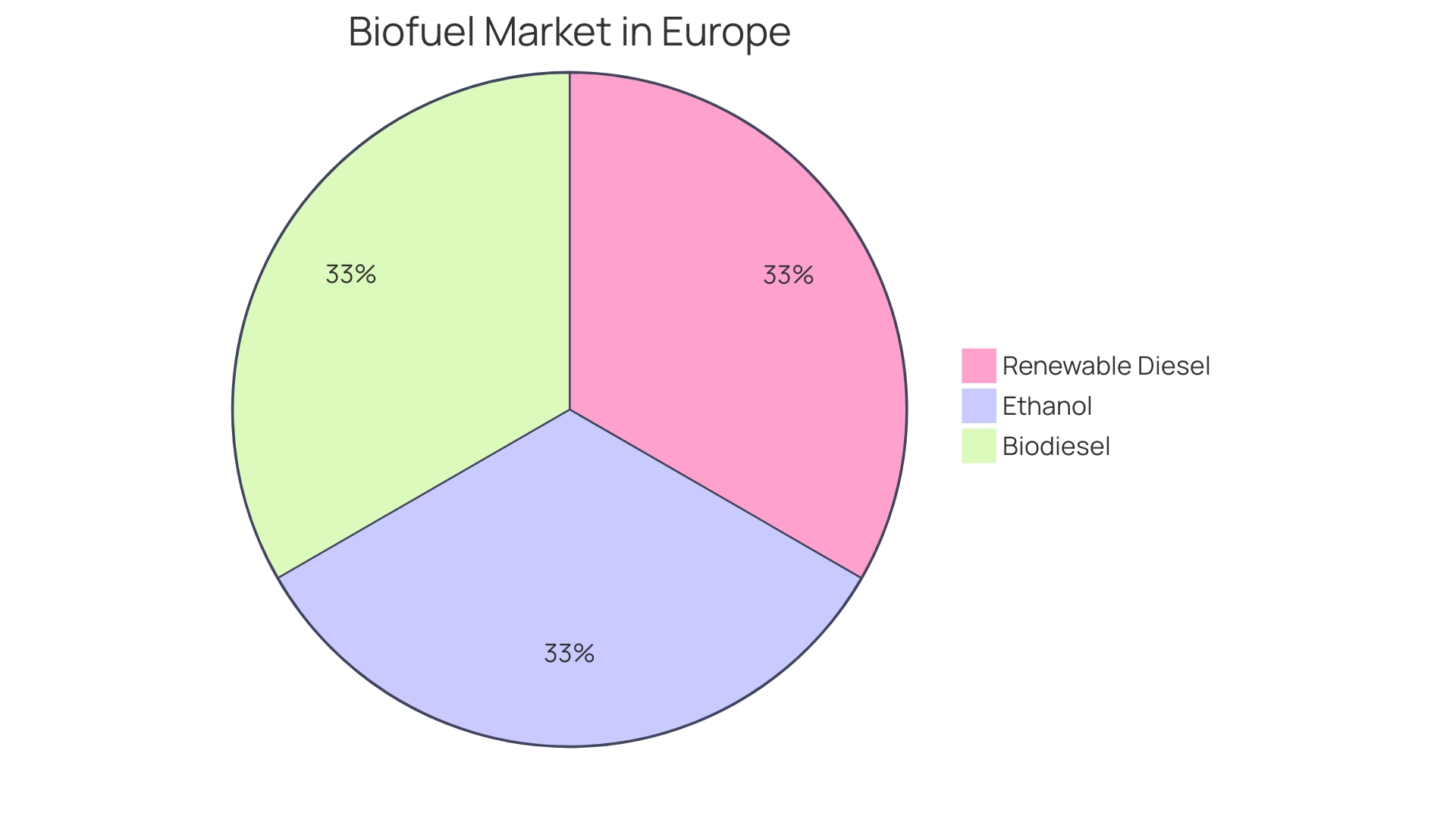Introduction
Biodiesel, a renewable liquid fuel derived from various feedstocks, plays a significant role in the renewable fuels industry. Its cold flow properties, particularly in colder climates, are crucial for ensuring optimal performance. In this article, we will explore the impact of cold weather on biodiesel, the key parameters to consider, and strategies for improving its cold weather performance.
We will also delve into the complexities of biodiesel's relationship with nitrogen oxide (NOx) emissions and highlight a case study showcasing successful biodiesel utilization in cold weather conditions. By understanding and addressing these factors, we can further optimize biodiesel for diverse climates and foster its integration into the current energy mix.
Understanding Cold Flow Properties of Biodiesel
B100, also known as pure biodiesel in its unblended form, is a renewable liquid fuel used in compression-ignition engines, with properties influenced by its various feedstocks, such as vegetable oils or animal fats. Since the bio-based diesel market, which encompasses both renewable diesel and vegetable oil-derived fuel, primarily sources over 80% of its raw materials from vegetable oils, the flow properties in colder climates of this type of diesel fuel become a crucial factor for its performance.
The physical characteristics of alternative fuel are essential in understanding its behavior in low-temperature environments. The combination of alternative fuel, its particular source material, and the characteristics of the conventional diesel it is mixed with all play a role in its performance in low temperatures. Typically, blends with lower alternative fuel content exhibit better functionality in cold conditions.
Recent studies have shed light on the impact of a certain type of fuel on the performance and emissions of a specific type of vehicle, revealing that it can enhance specific elements of vehicle functioning but also poses difficulties. A particularly contentious issue is the impact of this alternative fuel on nitrogen oxide (NOx) emissions. While some studies suggest an increase in NOx emissions from the combustion of alternative fuel derived from vegetable oils, contributing to air pollution and adverse health effects, others report a decrease, highlighting the complexity of this relationship and the need for further investigation into the various factors at play, including engine type, operating conditions, and the source of the alternative fuel.
The Climate Ethanol Alliance, with a foundation established through more than 20 years of real-world implementation, emphasizes the significance of ongoing innovation and evidence-based policy in the domain of renewable fuels such as ethanol. Their support for renaming ethanol, because of its demonstrated efficiency and contribution to climate mitigation, mirrors the ongoing endeavors to enhance alternative fuel for different climates and its integration into the current mix of power sources.
Professor Andrzej Vogt of the University of Wroclaw, a leading figure in biofuel research, emphasizes that innovations in the field can offer incredible opportunities for the future. Biodiesel's potential lies in its ability to complement renewable energy technologies, offering a reliable energy source that integrates with existing infrastructure, thereby supporting a sustainable and resilient energy economy.
Key Cold Flow Parameters: Cloud Point, Pour Point, and Cold Filter Plugging Point
In the field of alternative fuel, comprehending its performance in colder climates is crucial. The important metrics to consider are the cloud point, pour point, and filter plugging point. The cloud point indicates the onset of wax crystals forming in the fuel, resulting in a cloudy appearance. This can affect fuel flow and filterability. The pour point reflects the lowest temperature at which the alternative fuel maintains its fluidity, beyond which it ceases to pour. The filter plugging point is another important parameter, indicating the temperature at which the fuel might begin obstructing the filter, potentially resulting in start-up issues or even failure. These measures are necessary for evaluating the feasibility of alternative fuel in regions experiencing low temperatures, ensuring that engines operate efficiently without jeopardizing performance. It is through these insights that we can further optimize biodiesel for chilly weather use, contributing to the broader adoption of renewable fuels in various climatic conditions.

Impact of Cold Weather on Biodiesel Performance
Biodiesel's cold weather performance is a nuanced subject due to its tendency to solidify at lower temperatures, which could lead to phase separation. This leads to the creation of solids, potentially obstructing fuel filters and affecting motor performance negatively. Moreover, the heightened thickness of biofuel in colder regions poses supplementary difficulties, as it can impede the fuel's capacity to move easily through fuel lines and injectors. Such viscosity-related issues may contribute to decreased fuel efficiency, heightened emissions, and the possibility of motor harm. The intricacy of the relationship between the alternative fuel and nitrogen oxide (NOx) emissions is also remarkable. NOx, a significant air pollutant, has been reported to increase with the use of alternative diesel fuel according to several studies, although this is not a unanimous finding and varies depending on engine type, operating conditions, and the source of the alternative diesel fuel. This highlights the necessity for ongoing investigation to fully understand the influence of biofuel on NOx emissions and to develop plans to decrease them, taking into account biofuel's potential as a more environmentally friendly source of fuel. On a broader scale, the bio-based economy's continuous technological advancements have bolstered the viability of biofuels like ethanol, demonstrating significant climate, rural development, farming, energy independence, and air quality benefits. These developments highlight the importance of evidence-based policymaking in the reassessment of biofuels roles in sustainable transport solutions.
Strategies for Improving Cold Weather Performance of Biodiesel
Improvements in the production and application methods of alternative fuel are crucial for enhancing its effectiveness in lower temperature environments. By improving production processes, the amount of impurities that can lead to phase separation and filter blockage is decreased, improving the stability of the biofuel. Incorporating No. Blending 1st grade diesel with another fuel effectively addresses flow issues in low temperatures by taking advantage of the diesel's lower flow characteristics. This strategic blending is crucial for maintaining fuel efficiency during colder months. Additionally, the inclusion of cold flow additives additionally enhances the resilience of biofuel against low temperatures, altering its properties to prevent gelling and guaranteeing seamless engine operation.
In the broader context of biofuels, the integration of pioneering technologies such as CELF-based biorefineries signifies a monumental shift from traditional biofuel production methods. This innovation facilitates the extraction of multiple valuable products from biomass, optimizing resource use. The Climate Ethanol Alliance's establishment and its advocacy for evidence-based policymaking in transport decarbonisation highlight the continuous evolution of biofuels, particularly ethanol, as a viable oil alternative with positive implications for climate action, rural development, and air quality.
Furthermore, the research and intellectual property spearheaded by Professor Andrzej Vogt at the University of Wroclaw, Poland, underpin the technological progress of BIOTERRAN biofuels. These biofuels are designed to complement and enhance the usefulness of other renewable power sources, such as wind and solar, thereby strengthening the dependability of supply chains.
Statistics from the National Renewable Energy Laboratory (NREL) emphasize the importance of addressing the challenges associated with biodiesel, including the potential increase in nitrogen oxide (NOx) emissions. This requires continuous research and innovation to reduce such emissions, ensuring the environmental advantages of bio-based diesel as a source of power. By confronting and resolving these complex issues, the biofuel industry can continue to contribute significantly to the energy transition and achieve a more sustainable future.

Case Study: Successful Use of Biodiesel in Cold Weather Conditions
Emphasizing the durability of a renewable fuel in demanding environments, a thorough analysis of its usage in a vehicle fleet exposed to severe winter conditions provides deep understanding. This case study meticulously analyzed how the fleet sustained dependable functioning through strategic adaptations for extreme low temperatures. Through the integration of improved production methods, combining high-quality diesel with superior-grade diesel, and the inclusion of flow enhancers, significant reductions in emissions were achieved without compromising operational dependability. The insights from this case offer an invaluable perspective on biodiesel's potential in cold climates and underscore the necessity for tailored solutions to overcome its low-temperature limitations.
Conclusion
In conclusion, biodiesel's cold flow properties are crucial for optimal performance in colder climates. Key parameters like cloud point, pour point, and cold filter plugging point must be considered to evaluate its suitability in low-temperature regions. Biodiesel's tendency to solidify and increase in viscosity at lower temperatures presents challenges for engine performance and emissions.
The relationship between biodiesel and nitrogen oxide (NOx) emissions is complex and requires further research to fully understand and develop strategies for reducing NOx emissions. Advancements in biodiesel production, such as refining processes and blending with No. 1 grade diesel, can enhance its cold weather performance.
The addition of cold flow additives also improves biodiesel's ability to withstand low temperatures.
Pioneering technologies like CELF-based biorefineries optimize resource use and contribute to the evolution of biofuels. Evidence-based policymaking, as demonstrated by the Climate Ethanol Alliance, reinforces the viability of biofuels like ethanol and their positive impact on climate action, rural development, and air quality.
A detailed case study highlights the adaptability and potential of biodiesel in extreme cold climates. By employing enhanced production techniques, blending with superior-grade diesel, and incorporating cold flow improvers, emission reductions were achieved without compromising reliability.
To summarize, optimizing biodiesel for diverse climates and integrating it into the energy mix requires understanding cold flow properties, considering key parameters, and implementing strategic improvements. Continued research, innovation, and evidence-based policymaking are crucial for the biofuel industry to contribute significantly to the energy transition and achieve a more sustainable future.




